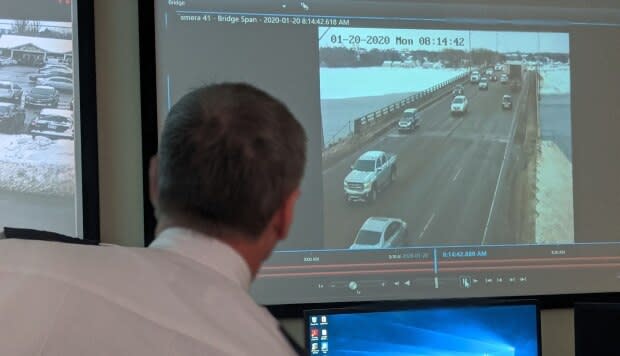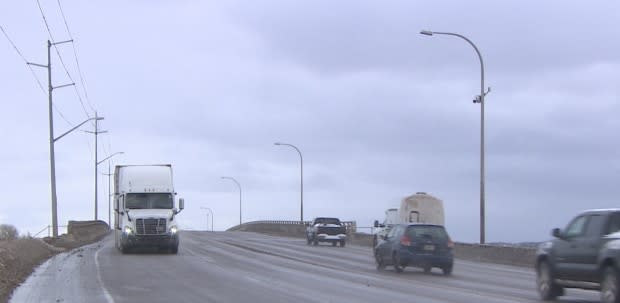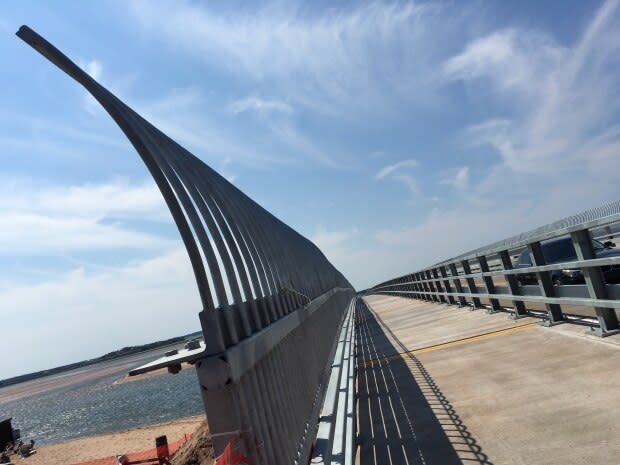Cameras on Hillsborough Bridge installed to help prevent suicide, respond to incidents
Two surveillance cameras installed on the Hillsborough Bridge may help save lives. They're providing Charlottetown police with an immediate view of anyone at risk of jumping. They're also intended to provide information on accidents and traffic problems.
The two new cameras are part of a system of 94 E-watch cameras positioned around the city that are monitored by police.
One camera is on the approach to the bridge between Charlottetown and Stratford. The other is just before the span itself and offers a view across the entire bridge.
The cameras can be turned or zoomed in, by police.

"I think it's great," said Coady McKinnon, although he's left wondering: "Why did it take so long?"
His mother, Stacey McKinnon-Smith, is believed to have ended her life on the bridge two years ago. Her body has never been found. E-watch cameras recorded her walking on to the bridge but lost sight of her there.
"We had no idea if my mom had jumped off the bridge or not," said McKinnon. "God forbid if anybody's ever in that state of mind and they go to do that. There will be cameras now so at least the families of the people who lost that family member will know they're gone.… At least they'll know. They'll have closure."
Without closure, he said, "You just feel kind of lost."

McKinnon was a member of a P.E.I. suicide prevention committee that recommended security cameras be installed two years ago. The group also recommended barriers on the Hillsborough Bridge and an emergency phone. All these recommendations were supported by the P.E.I. division of the Canadian Mental Health Association.
The video provides immediate eyes for police, if someone is at risk of self-harm, and also if there's an accident or if a major crime has been committed.
Charlottetown police don't monitor all 94 cameras, all the time, however. If they get word of an incident, they can check the specific camera right away. "Our response times are very good," said Brad MacConnell, deputy chief, Charlottetown Police Services.

"It's an unfortunate reality that we've had numerous people in the past choose to use the bridge as a way of … ending their life."
MacConnell acknowledges that the cameras are only one small measure to try to prevent tragedy on the bridge. "It's very hard to guard against that no matter what prevention or best practice you put in place."
It may not be possible, he said, to reach someone on the bridge to prevent them from jumping. However cameras will also be able to help with search and recovery operations or, "to offer some closure to the family or some insight into the last minutes of someone's life," he said.

Call for barriers continues
McKinnon would still like to see barriers erected to prevent suicides. "It could happen any time and I think that spending the money on that to save at least one life is worth it." He pointed to the Covehead Bridge barriers as an example, where barriers were installed to prevent swimmers from getting hurt by jumping off the bridge for fun.
His group also suggested an emergency phone be installed on the bridge that would go directly to 911 or the P.E.I. helpline.

The government has committed to adding a cycling/walking lane to the bridge that connects Charlottetown and Stratford. Work on the multi-use trail is scheduled to start in 2023 at an estimated cost of $5 million.
The province said it has not yet looked at options for barricades. In a statement emailed to CBC, the Department of Transportation said, "We are working with Stratford and Charlottetown to understand their active transportation plans so any potential active transportation path on the bridge links seamlessly into the trails on the other side. After this work, we will be doing more structural analysis of the bridge."
The two cameras were installed in partnership with the provincial government, which contributed $10,000 for the equipment.

They will also offer timely information about traffic accidents and backups. On average, more than 35,000 vehicles cross the bridge each day.
"It is a main artery to the city, a lifeline to the city, and out of the city," said MacConnell. "So the ability to have situational awareness in that area can't be understated," he said.
Anyone needing emotional support, crisis intervention or help with problem solving in P.E.I. can contact The Island Helpline at 1-800-218-2885, 24 hours a day, 7 days a week.
For more information about mental health services on P.E.I., find resources from Health PEI here, or from the Canadian Mental Health Association P.E.I. Division here.
More P.E.I. news


